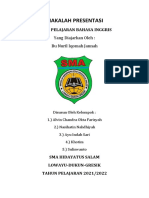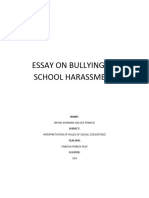0 ratings0% found this document useful (0 votes)
40 viewsTypes: Physical Bullying Psychological Bullying Verbal Bullying Social Bullying
Types: Physical Bullying Psychological Bullying Verbal Bullying Social Bullying
Uploaded by
leydiLeydi's presentation discusses bullying, defining it as physical, verbal or psychological abuse between students that occurs repeatedly over time. Bullying usually takes place in classrooms and schoolyards, affecting children ages 12 to 15 but sometimes other ages. The bully annoys the victim in different ways while others remain silent or complicit. Types of bullying include physical, psychological, verbal, and social bullying, as well as cyberbullying through technology. Characteristics of bullies are that they are hot-headed, like to dominate, believe they don't need to follow rules, lack empathy, and enjoy causing pain. Victims tend to be shy, socially isolated, insecure, physically weaker, or disabled. Members involved in bullying are
Copyright:
© All Rights Reserved
Available Formats
Download as DOCX, PDF, TXT or read online from Scribd
Types: Physical Bullying Psychological Bullying Verbal Bullying Social Bullying
Types: Physical Bullying Psychological Bullying Verbal Bullying Social Bullying
Uploaded by
leydi0 ratings0% found this document useful (0 votes)
40 views4 pagesLeydi's presentation discusses bullying, defining it as physical, verbal or psychological abuse between students that occurs repeatedly over time. Bullying usually takes place in classrooms and schoolyards, affecting children ages 12 to 15 but sometimes other ages. The bully annoys the victim in different ways while others remain silent or complicit. Types of bullying include physical, psychological, verbal, and social bullying, as well as cyberbullying through technology. Characteristics of bullies are that they are hot-headed, like to dominate, believe they don't need to follow rules, lack empathy, and enjoy causing pain. Victims tend to be shy, socially isolated, insecure, physically weaker, or disabled. Members involved in bullying are
Original Title
El bullying
Copyright
© © All Rights Reserved
Available Formats
DOCX, PDF, TXT or read online from Scribd
Share this document
Did you find this document useful?
Is this content inappropriate?
Leydi's presentation discusses bullying, defining it as physical, verbal or psychological abuse between students that occurs repeatedly over time. Bullying usually takes place in classrooms and schoolyards, affecting children ages 12 to 15 but sometimes other ages. The bully annoys the victim in different ways while others remain silent or complicit. Types of bullying include physical, psychological, verbal, and social bullying, as well as cyberbullying through technology. Characteristics of bullies are that they are hot-headed, like to dominate, believe they don't need to follow rules, lack empathy, and enjoy causing pain. Victims tend to be shy, socially isolated, insecure, physically weaker, or disabled. Members involved in bullying are
Copyright:
© All Rights Reserved
Available Formats
Download as DOCX, PDF, TXT or read online from Scribd
Download as docx, pdf, or txt
0 ratings0% found this document useful (0 votes)
40 views4 pagesTypes: Physical Bullying Psychological Bullying Verbal Bullying Social Bullying
Types: Physical Bullying Psychological Bullying Verbal Bullying Social Bullying
Uploaded by
leydiLeydi's presentation discusses bullying, defining it as physical, verbal or psychological abuse between students that occurs repeatedly over time. Bullying usually takes place in classrooms and schoolyards, affecting children ages 12 to 15 but sometimes other ages. The bully annoys the victim in different ways while others remain silent or complicit. Types of bullying include physical, psychological, verbal, and social bullying, as well as cyberbullying through technology. Characteristics of bullies are that they are hot-headed, like to dominate, believe they don't need to follow rules, lack empathy, and enjoy causing pain. Victims tend to be shy, socially isolated, insecure, physically weaker, or disabled. Members involved in bullying are
Copyright:
© All Rights Reserved
Available Formats
Download as DOCX, PDF, TXT or read online from Scribd
Download as docx, pdf, or txt
You are on page 1of 4
Good afternoon. My name is Leydi.
And I going to talk
about the bullying.
Definition: Bullying refers to all forms of physical, verbal
or psychological abuse that occurs between students,
repeatedly over time.
Bullying usually takes place in the classroom and in the
schoolyard. This type of violence affects children
between 12 and 15 years, but may extend to other
ages.
The assailant or stalker annoys his victim in different
ways, in the face of the silence or complicity of other
colleagues. Usually the conflict begins with taunts that
become systemic and can lead to stroke or physical
aggression.
Types:
Physical bullying
Psychological bullying
Verbal bullying
Social bullying
CyberBullying: With the penetration of new
technologies, the existence of such acts, involving
cyber harass other people, are becoming more
frequent. Acts of humiliation are generated through
various channels, such as social networks, websites,
blogs, and messaging services.
Characteristics of a student who applies Bullying.
1. Bullies are hot-headed and impulsive. They don't
think a situation through or consider
consequences.
2. Bullies like to dominate others and feel as if he or
she is the "boss".
3. Bullies have difficulty respecting rules and
believe they do not need to follow the rules.
4. Bullies lack empathy. In other words they do not
consider the feeling of others.
5. Bullies often enjoy causing pain to others.
6. Bullies believe they are not responsible for their
actions and blame others.
Characteristics of a bully victim.
Shy or socially isolated. A student who bullies may
select another student who has few or no friends
on his or her side.
Insecure and sensitive.
Physically weaker than the student who is the
bully. More often this factor applies to boys.
Disabled physically, developmentally, or have a
learning disability.
Who are the members of bullying?
The aggressor: They are usually children who want to
lead groups, to be recognized. Harassment occurs
regardless of sex. In general, the perpetrator is a
person who seeks recognition and acceptance. In
many cases, it has a past of abuse in his family.
The victim: Regarding victims are usually very
obedient children, quiet, introverted, with self-esteem
an issue that probably comes from violent
environments. Like the aggressor, the gender is not
decisive.
Observers or witnesses: Is anyone who is not
involved either as a victim or as an Aggressor, but it is
present.
How do I prevent it?
Know and listen to children and adolescents to
adequately address issues such as bullying.
Devote quality time for than are feeling important
in the family, loved and trusted.
Be alert to any sign that reflects a situation of
violence, either not wanting to go to school,
changes in routine or mood in children and
adolescents.
Canalize before the Board of Protection of
Children and Adolescents any case of threat or
violence to their rights.
You might also like
- LGBTQ+ History Month ProclamationDocument1 pageLGBTQ+ History Month ProclamationMatt PapaycikNo ratings yet
- Bullying As Reflected in Wonder by RJ Palacio 2Document9 pagesBullying As Reflected in Wonder by RJ Palacio 2callista giovanniNo ratings yet
- Feminism DBQDocument1 pageFeminism DBQAnushka NayakNo ratings yet
- BULLYNGDocument11 pagesBULLYNGalbamorales-2012No ratings yet
- BullyingDocument3 pagesBullyingEka Putria SariNo ratings yet
- Bullying-How To Tackle ItDocument4 pagesBullying-How To Tackle ItMeghnaNo ratings yet
- Bullying (Makalah B.ing)Document6 pagesBullying (Makalah B.ing)Nasikhatin NhdhyhNo ratings yet
- Bullying and Its Impact On Someone's LifeDocument5 pagesBullying and Its Impact On Someone's LifeWinona ShafiraNo ratings yet
- Investigation 1Document19 pagesInvestigation 1ScribdTranslationsNo ratings yet
- Revision and Self Reflection (Ghina Meidiana Utami)Document3 pagesRevision and Self Reflection (Ghina Meidiana Utami)Diana UtamiNo ratings yet
- Lecture School BullyingDocument29 pagesLecture School BullyingSalug MPSNo ratings yet
- Type of BehaviourDocument18 pagesType of BehaviourSella AmeliaNo ratings yet
- BullyDocument9 pagesBullyJoelebieNo ratings yet
- Bullying Is UnwantedDocument18 pagesBullying Is UnwantedAria MoonNo ratings yet
- Torres Essay c6Document3 pagesTorres Essay c6Cheska TorresNo ratings yet
- BullyingDocument15 pagesBullyingAvina MunawarNo ratings yet
- Serious, Lasting Problems: o o o o oDocument8 pagesSerious, Lasting Problems: o o o o oSri Jagadamba JewellersNo ratings yet
- Artikel Bahasa Inggris Tentang BullyingDocument2 pagesArtikel Bahasa Inggris Tentang BullyingWati100% (1)
- BullyDocument5 pagesBullyapi-410859930No ratings yet
- Bullying Oratory SpeechDocument5 pagesBullying Oratory SpeechScribdTranslationsNo ratings yet
- Bullying SlideshowDocument29 pagesBullying SlideshowJey Vlack100% (1)
- All About BullyingDocument12 pagesAll About BullyingMind You & OthersNo ratings yet
- BullyingDocument15 pagesBullyingAzrizal AhmadNo ratings yet
- Bullying Is An Ongoing and Deliberate Misuse of Power in Relationships Through Repeated VerbalDocument4 pagesBullying Is An Ongoing and Deliberate Misuse of Power in Relationships Through Repeated VerbalAngelNo ratings yet
- What Is BullyingDocument8 pagesWhat Is BullyingSerena MileNo ratings yet
- Case Study: (Bullying)Document6 pagesCase Study: (Bullying)RuthNo ratings yet
- Bullying Articol 21 Martie 2024Document3 pagesBullying Articol 21 Martie 2024mihaela.zachmanNo ratings yet
- English Nama: Vanessa - Bakarbessy NIM: 201928016Document1 pageEnglish Nama: Vanessa - Bakarbessy NIM: 201928016Vanessa BakarbessyNo ratings yet
- BULLYNGDocument3 pagesBULLYNGtercerob.medicinauteNo ratings yet
- Bullying: The Problems OF in SchoolsDocument67 pagesBullying: The Problems OF in SchoolsLeigh Paz Fabrero-Urbano100% (1)
- Bullying SpeechDocument5 pagesBullying Speechdvtans100% (2)
- Proven Bullying Issues Solution That Gives Fast Result Easily In No TimeFrom EverandProven Bullying Issues Solution That Gives Fast Result Easily In No TimeNo ratings yet
- Speech About BullyingDocument2 pagesSpeech About BullyingAbielNo ratings yet
- BULLYING Text For Parents 8Document4 pagesBULLYING Text For Parents 8ScribdTranslationsNo ratings yet
- Bullying - EspDocument6 pagesBullying - EspAle FloresNo ratings yet
- About Bullying RydoDocument5 pagesAbout Bullying RydoRydo A.F.R.DNo ratings yet
- Rems 000094 0001Document24 pagesRems 000094 0001SupriantoNo ratings yet
- Bullying Argument EssayDocument2 pagesBullying Argument EssayRaisa Pitas MalayNo ratings yet
- Different Kinds of BullyingDocument8 pagesDifferent Kinds of BullyingRaymund BondeNo ratings yet
- BullyingDocument24 pagesBullyingEdilson Bonifacio ceferinoNo ratings yet
- Effects of BullyingDocument25 pagesEffects of Bullyingalmiraafable022100% (1)
- BullingDocument5 pagesBullingnadalista1No ratings yet
- Bully 10 03 eDocument2 pagesBully 10 03 eلقمان بن مد ابوNo ratings yet
- Bullying and Its Impact On Someone's Life: By: Aura Satya Pinasti (1801050043) Silfi Febritha (1801050056)Document22 pagesBullying and Its Impact On Someone's Life: By: Aura Satya Pinasti (1801050043) Silfi Febritha (1801050056)Aura Satya100% (1)
- Bullying Persuasive Speech Chandra ErickDocument32 pagesBullying Persuasive Speech Chandra ErickChandra ErickNo ratings yet
- Cheryl FinalDocument5 pagesCheryl FinalJoshua WinataNo ratings yet
- Bullying and Teasing: No Laughing MatterDocument6 pagesBullying and Teasing: No Laughing MatterAlmas SofiyaNo ratings yet
- Bullying 2Document2 pagesBullying 2Angelyn FernandezNo ratings yet
- William Shakespeare, ÔDocument4 pages William Shakespeare, ÔDrJigar PandyaNo ratings yet
- Bullying: Fundamental English WEB 10302Document18 pagesBullying: Fundamental English WEB 10302ابو حنيفNo ratings yet
- BullyngDocument2 pagesBullyngyogaNo ratings yet
- Name: Nailah Syarafina Teguh Putri Class: 1SA02 NPM: 14619655 Mid Test Writing 2 ActionDocument3 pagesName: Nailah Syarafina Teguh Putri Class: 1SA02 NPM: 14619655 Mid Test Writing 2 Actionsafira dinaNo ratings yet
- Teks Diskusi PLPGDocument6 pagesTeks Diskusi PLPGKarlonius Bambang PurwantoNo ratings yet
- Group 21Document7 pagesGroup 21Shubham ThorboleNo ratings yet
- Violencia IntrafamiliarDocument3 pagesViolencia IntrafamiliarManuel AlejandroNo ratings yet
- English Project RishitDocument10 pagesEnglish Project RishitKashvi DevNo ratings yet
- Bullying Definition: Back To TopDocument4 pagesBullying Definition: Back To TopAriel Dela CuevaNo ratings yet
- Essay On Bullying or Harassment at SchoolDocument5 pagesEssay On Bullying or Harassment at SchoolScribdTranslationsNo ratings yet
- Essay On School BullyingDocument6 pagesEssay On School BullyingTheHatLadyNo ratings yet
- Criminology: Definition and Concept of CriminologyDocument19 pagesCriminology: Definition and Concept of Criminologyansh patel100% (2)
- Besson The Principle of Non-Discrimination in CRCDocument33 pagesBesson The Principle of Non-Discrimination in CRCFrancisco EstradaNo ratings yet
- Assignment of Human Rights IbrarDocument7 pagesAssignment of Human Rights IbrarPeer Abdul WaheedNo ratings yet
- NCERT Solutions For Class 11 Political Science Indian Constitution at Work Chapter 2Document7 pagesNCERT Solutions For Class 11 Political Science Indian Constitution at Work Chapter 2Dhruv AgarwalNo ratings yet
- CSH02 SongAnalysis MarianoDocument4 pagesCSH02 SongAnalysis MarianoMariano CedrickNo ratings yet
- Health EducationDocument6 pagesHealth EducationMary Rose PlataNo ratings yet
- Ngo Te v. Yu-Te Case DigestDocument2 pagesNgo Te v. Yu-Te Case DigestMan2x Salomon100% (4)
- Prefatory StatementDocument2 pagesPrefatory StatementAko Si CrokieNo ratings yet
- The Social Dilemma QuestionsDocument2 pagesThe Social Dilemma QuestionsNathalieNo ratings yet
- Press Controlling Free SpeechDocument24 pagesPress Controlling Free SpeechNicoleNo ratings yet
- Public Prosecutor SyllabusDocument1 pagePublic Prosecutor SyllabusDivytwa UmareNo ratings yet
- Executive Order No. 12 - (BHRAC)Document2 pagesExecutive Order No. 12 - (BHRAC)rogelio ramiroNo ratings yet
- Democratic RightsDocument10 pagesDemocratic Rightskdesteen268No ratings yet
- Type of SettlementDocument8 pagesType of SettlementBayyinah ManjooNo ratings yet
- Global Issues That Concern Schools and SocietyDocument23 pagesGlobal Issues That Concern Schools and SocietyMary Grace Apinado100% (1)
- Same-Sex Marriage - Position PaperDocument3 pagesSame-Sex Marriage - Position Paperrodel tagaoNo ratings yet
- Love Bites ProgramDocument3 pagesLove Bites Programapi-298820218No ratings yet
- Domestic Violence Public DocumentDocument3 pagesDomestic Violence Public Documentapi-272440888No ratings yet
- BSA3B - Activity - GAD LawsDocument3 pagesBSA3B - Activity - GAD LawsPhebe LagutaoNo ratings yet
- Verbal Bullying - For PrintingDocument22 pagesVerbal Bullying - For Printingmarja nocosNo ratings yet
- BiiiDocument2 pagesBiiiRogin Alrea Mae PalermoNo ratings yet
- Presentation - VAWCDocument22 pagesPresentation - VAWCAnjanette MangalindanNo ratings yet
- LMS DATA-updatedDocument1 pageLMS DATA-updatedHareem AkhtarNo ratings yet
- RAIO Directorate Officer Training ManualDocument834 pagesRAIO Directorate Officer Training ManualSai Sunil ChandraaNo ratings yet
- Factors Leading To Military Rule in A CountryDocument3 pagesFactors Leading To Military Rule in A CountrySohail NasirNo ratings yet
- The Truth About Zero, Katie, and SkyDocument9 pagesThe Truth About Zero, Katie, and SkyMichael ChangNo ratings yet
- Scholarly Articles: Govern DocuDocument2 pagesScholarly Articles: Govern Docunicole bejasaNo ratings yet
- American Convention On Human RightsDocument14 pagesAmerican Convention On Human Rightssandhya lakshmanNo ratings yet

























































































